Plasmin activity promotes amyloid deposition in a transgenic model of human transthyretin amyloidosis
- PMID: 34876572
- PMCID: PMC8651690
- DOI: 10.1038/s41467-021-27416-z
Plasmin activity promotes amyloid deposition in a transgenic model of human transthyretin amyloidosis
Abstract
Cardiac ATTR amyloidosis, a serious but much under-diagnosed form of cardiomyopathy, is caused by deposition of amyloid fibrils derived from the plasma protein transthyretin (TTR), but its pathogenesis is poorly understood and informative in vivo models have proved elusive. Here we report the generation of a mouse model of cardiac ATTR amyloidosis with transgenic expression of human TTRS52P. The model is characterised by substantial ATTR amyloid deposits in the heart and tongue. The amyloid fibrils contain both full-length human TTR protomers and the residue 49-127 cleavage fragment which are present in ATTR amyloidosis patients. Urokinase-type plasminogen activator (uPA) and plasmin are abundant within the cardiac and lingual amyloid deposits, which contain marked serine protease activity; knockout of α2-antiplasmin, the physiological inhibitor of plasmin, enhances amyloid formation. Together, these findings indicate that cardiac ATTR amyloid deposition involves local uPA-mediated generation of plasmin and cleavage of TTR, consistent with the previously described mechano-enzymatic hypothesis for cardiac ATTR amyloid formation. This experimental model of ATTR cardiomyopathy has potential to allow further investigations of the factors that influence human ATTR amyloid deposition and the development of new treatments.
© 2021. The Author(s).
Conflict of interest statement
The authors declare no competing interests.
Figures

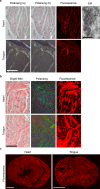

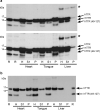
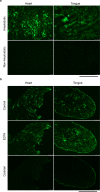
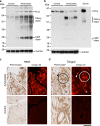

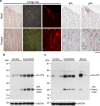
Similar articles
-
In Vitro and In Vivo Effects of SerpinA1 on the Modulation of Transthyretin Proteolysis.Int J Mol Sci. 2021 Aug 31;22(17):9488. doi: 10.3390/ijms22179488. Int J Mol Sci. 2021. PMID: 34502397 Free PMC article.
-
Plasminogen activation triggers transthyretin amyloidogenesis in vitro.J Biol Chem. 2018 Sep 14;293(37):14192-14199. doi: 10.1074/jbc.RA118.003990. Epub 2018 Jul 17. J Biol Chem. 2018. PMID: 30018138 Free PMC article.
-
Amyloid seeding of transthyretin by ex vivo cardiac fibrils and its inhibition.Proc Natl Acad Sci U S A. 2018 Jul 17;115(29):E6741-E6750. doi: 10.1073/pnas.1805131115. Epub 2018 Jun 28. Proc Natl Acad Sci U S A. 2018. PMID: 29954863 Free PMC article.
-
From Molecular to Radionuclide and Pharmacological Aspects in Transthyretin Cardiac Amyloidosis.Int J Mol Sci. 2024 Dec 27;26(1):146. doi: 10.3390/ijms26010146. Int J Mol Sci. 2024. PMID: 39796004 Free PMC article. Review.
-
Transthyretin (ATTR) amyloidosis: clinical spectrum, molecular pathogenesis and disease-modifying treatments.J Neurol Neurosurg Psychiatry. 2015 Sep;86(9):1036-43. doi: 10.1136/jnnp-2014-308724. Epub 2015 Jan 20. J Neurol Neurosurg Psychiatry. 2015. PMID: 25604431 Review.
Cited by
-
Development of Imaging Endpoints for Clinical Trials in AL and ATTR Amyloidosis: Proceedings of the Amyloidosis Forum.JACC Cardiovasc Imaging. 2025 May;18(5):602-617. doi: 10.1016/j.jcmg.2024.11.003. Epub 2025 Feb 21. JACC Cardiovasc Imaging. 2025. PMID: 39985507 Free PMC article. Review.
-
Uncovering cell type-specific phenotypes using a novel human in vitro model of transthyretin amyloid cardiomyopathy.Stem Cell Res Ther. 2025 Jul 6;16(1):352. doi: 10.1186/s13287-025-04464-6. Stem Cell Res Ther. 2025. PMID: 40619379 Free PMC article.
-
Proteomic Evidence for Amyloidogenic Cross-Seeding in Fibrinaloid Microclots.Int J Mol Sci. 2024 Oct 8;25(19):10809. doi: 10.3390/ijms251910809. Int J Mol Sci. 2024. PMID: 39409138 Free PMC article.
-
Mechanisms of damage and therapies for cardiac amyloidosis: a role for inflammation?Clin Res Cardiol. 2024 Aug 21. doi: 10.1007/s00392-024-02522-2. Online ahead of print. Clin Res Cardiol. 2024. PMID: 39167195 Review.
-
Molecular Mechanism of Pathogenesis and Treatment Strategies for AL Amyloidosis.Int J Mol Sci. 2022 Jun 6;23(11):6336. doi: 10.3390/ijms23116336. Int J Mol Sci. 2022. PMID: 35683015 Free PMC article. Review.
References
-
- Benson MD, et al. Amyloid nomenclature 2020: update and recommendations by the international society of amyloidosis (ISA) nomenclature committee. Amyloid. 2020;27:217–222. - PubMed
-
- Cornwell GG, Murdoch WL, Kyle RA, Westermark P, Pitkanen P. Frequency and distribution of senile cardiovascular amyloid - a clinicopathologic correlation. Am. J. Med. 1983;75:618–623. - PubMed
-
- Nakamichi K, Tachibana S. Histology of the transverse carpal ligament and flexor tenosynovium in idiopathic carpal tunnel syndrome. J. Hand Surg. Am. 1998;23:1015–1024. - PubMed
-
- Tanskanen M, et al. Senile systemic amyloidosis affects 25% of the very aged and associates with genetic variation in alpha2-macroglobulin and tau: a population-based autopsy study. Ann. Med. 2008;40:232–239. - PubMed
Publication types
MeSH terms
Substances
Supplementary concepts
Grants and funding
LinkOut - more resources
Full Text Sources
Molecular Biology Databases
Research Materials
Miscellaneous

